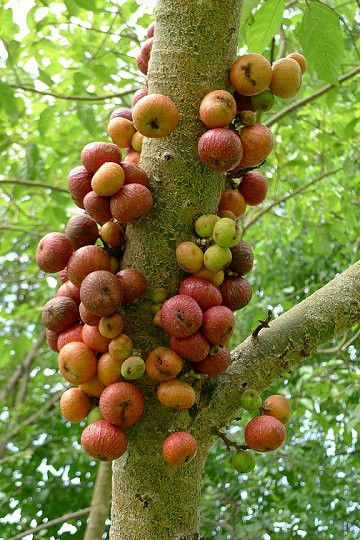
|
|
Gular - Cluster fig
(Ficus racemosa). Fruits.
|
Gular - Cluster fig - Ficus racemosa
Ficus racemosa, the cluster fig, red river fig or gular, is a species of plant in the family Moraceae. It is native to Australia and tropical Asia. It is a fast-growing plant with large, very rough leaves, usually attaining the size of a large shrub, although older specimens can grow quite large and gnarled. It is unusual in that its figs grow on or close to the tree trunk, termed cauliflory.
Cluster fig is an evergreen or, in drier areas, deciduous tree, often with an irregular crown; it can grow 20 - 30 metres tall. The bole becomes deeply buttressed as the tree grows older and can be 36 - 90cm in diameter.
Goolar is an attractive fig tree witha crooked trumk and a spreading crown. Unlike the banyan, it has no aerial roots. The most distinctive aspect of this tree is the red, furry figs in short clusters, which grow directly out of the trunk of the tree.
Those looking for the flower of goolar should know that the fig is actually a compartment carrying hundreds of flowers. One might wonder how these flowers enclosed in a ball are pollinated. The flowers are pollinated by very small wasps that crawl through the opening in search of a suitable place to reproduce (lay eggs). Without this pollinator service fig trees cannot reproduce by seed. In turn, the flowers provide a safe haven and nourishment for the next generation of wasps.
Goolar is a tree commonly found in cities and towns. It has evergreen leaves, if it is close to a water source. Otherwise it sheds its leaves in january.
The tree is harvested from the wild for local use as a food and medicine. It is often cultivated, both for its fruit and also as a shade tree in plantations and an ornamental tree in parks, large gardens etc.
Fruits ares eaten raw or cooked. Sweet, but rather insipid.
The fruits are commonly eaten as a vegetable after the seeds have been discarded, and made into stir-fries and curries. They are used in various preserves and side-dishes. Unripe fruits are pickled and used in soups. The fruit can be dried and ground into a flour then eaten with sugar and milk. The powder from roasted fruits forms a valuable breakfast food. In times of scarcity, the unripe fruit is pounded, mixed with flour and made into cakes. The fruit is up to 25mm in diameter.
The leaves are eaten as vegetable. Young shoots are eaten raw or cooked.
The roots can be cut to provide a liquid that can be drunk as water.
Ficus racemosa has long been used in Ayurveda, the traditional and ancient system of Indian medicine. It is also one of the sacred trees of Buddhists and Hindus.
Medicinal. The leaves are used in the treatment of diarrhoea.
The bark is astringent. It is used in the treatment of haematuria, menorrhagia, and haemoptysis.
The bark of Ficus racemosa is used as a home remedy. In India, the bark is rubbed on a stone with water to make a paste, which can be applied to boils or mosquito bites. Allow the paste to dry on the skin and reapply after a few hours. The rough leaves of the plant can also be used to remove caterpillar bristles lodged in skin. A common folk remedy is to rub the affected area lightly with a leaf, which effectively dislodges the stinging hairs.
The fruit is astringent. It is used in the treatment of haematuria, menorrhagia, and haemoptysis. The fruit, when filled with sugar, is considered to be very cooling.
A fluid that exudes from the cut roots of the tree is considered to be a powerful tonic when drunk for several days together.
The sap is a popular remedy in Bombay, that is applied locally to mumps and other inflammatory glandular enlargements, and is also used in the treatment of gonorrhoea.
The root is chewed as a treatment for tonsilitis.
Source:
https://en.wikipedia.org/wiki/Ficus_racemosa
http://tropical.theferns.info/viewtropical.php?id=Ficus+racemosa
http://www.flowersofindia.net/catalog/slides/Goolar.html
